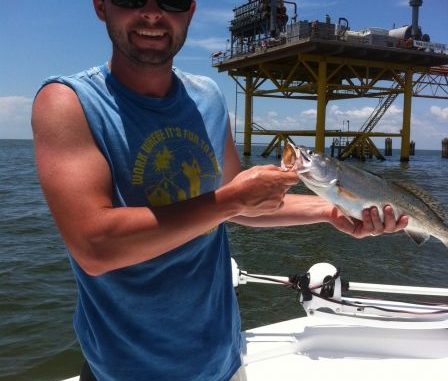
Rigs providing fish habitat in Ship Shoal 26 falling victim to Idle Iron Policy, could still be added to Artificial Reef Program.
The Pickets are hallowed ground in the Houma trout-fishing world. If you fish out of Cocodrie and Dularge during the summer, the odds are pretty darned good you schedule time at this perennial hotspot to add big specks to your box.
That’s because trout migrate out of the marshes as the temperatures soar, and many of those that don’t stop on coastal beaches make their way to the big rig and the set of pilings in Ship Shoal 26, as the area is officially known.
However, the Idle Iron Policy that has resulted in the removal of so many deepwater rigs has now set its sites on The Pickets, and work is already underway to remove all the structure in the oil-field block.
“They’ve already started pulling some of those wellheads and pilings,” Absolute Fishing Charters’ Capt. Marty LaCoste said. “I talked to some guys on the rig (recently), and they said in two weeks the rig would be gone.
“That’s huge. This is going to be a huge impact on the fishing.”
The federal Bureau of Safety and Environmental Enforcement acknowledged that Apache Corporation, which owned the Ship Shoal 26 lease until it expired last fall, has a permit to remove the large rig, the smaller wellheads and standing casings in the area.
“The lease terminated about November of 2012, and the regulations — the law — say they have to remove it within a year of the lease terminating,” BSEE’s Environmental Safety chief T.J. Broussard said.
The structures stand in roughly 10 feet of water, so dropping the material to serve as an artificial reef isn’t an option.
However, Broussard said his office would be more than willing to work with Apache and the Louisiana Department of Wildlife and Fisheries so the material doesn’t go to waste.
“It’s not too dilapidated, so we would be able to offer Apache extra time to get it into the Artificial Reef Program,” Broussard said.
In fact, he said his office recently stopped removal work on three platforms the owners were planning to haul back to shore for dismantling because they were within a mile of an established artificial reef site. BSEE officials are now working with the company to convince them to add the structures to the program.
The final call about the fate of The Pickets is strictly up to Apache, but even if an agreement is worked out between the oil exploration company and LDWF, it probably won’t help the anglers who fish The Pickets.
While Broussard said the U.S. Coast Guard has softened its traditional insistence that any artificial reef must have a minimum of 85 feet of clearance, but buoys would still be required for this site because it is so shallow.
And that’s where the problem comes in.
“The state doesn’t want to foot the bill for buoys and markers,” Broussard said.
LDWF Artificial Reef Program staffers could not be reached for comment today.
Leaving the structures standing probably won’t make the cut, either, he said.
“Generally, the operators don’t like to have anything (left) above the water, and the state is hesitant to take platforms,” Broussard said.
Broussard said it could take a few months for all the work in Ship Shoal 26 to be completed, opening up the possibility of saving at least part of the facility.
However, if Apache is unwilling to budge or if LDWF officials refuse to accept responsibility for a shallow-water reef in the area, there won’t be much left; Broussard said all pilings must be cut off 15 feet below the mud line.
Removal of any shell pad, which can serve as fish habitat, is not required, but Broussard acknowledged that it doesn’t take much to cover these shell with a layer of mud.
LaCoste pointed to another lost rig over in Ship Shoal 35 as an example of what can be expected if the Pickets disappears.
“There’s nothing left,” he said. “There’s no structure, there’s nothing on the bottom to attract fish.”